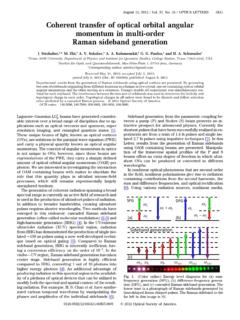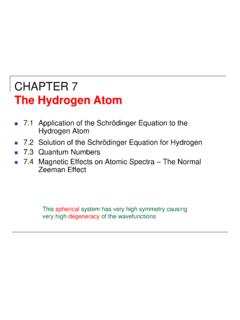Transcription of Mode-locking - sibor.physics.tamu.edu
1 Mode-locking James Bounds Overview Basic Idea of Mode-locking How modelocking is achieved Active Passive Theory Examples of real lasers Dispersion pulse measurement Mode-locking Basic Idea Mode-locking Basic Idea Active Mode-locking Variations of Active Mode-locking Synchronous phase modulation Regenerative Harmonic Synchronously pumped laser Hybrid Passive Mode-locking using saturable absorbers An intra-cavity saturable absorber is able to fix phase of cavity modes Variations Slow Saturable Absorber Fast Saturable Absorber Kerr-lens effect Slow Saturable Abosorber Modelocked Laser Slow Saturable Absorber Sub-picosecond pulse generation with passive mode- locking first demonstrated in early 1970s Dye laser <100 femtosecond pulses first demonstrated with a colliding pulse mode-locked ring dye laser Relaxation times for dyes typically on order of nanoseconds How pico/femtosecond pulses can be produced from such long absorber lifetime?
2 Theory of Haus in mid-1970s Active Modelocking Passive Modelocking The action of passive modelocking can be modeled using a time-dependent gain and loss Modelocked pulse is self-consistent solution Quantitative Analysis Passive Modelocking Equation Suppose we have an initial pulse envelope with Fourier transform Modelocking Equation We take into account cavity by writing Here is the linear time independent loss Filtering term describes the finite bandwidth of the cavity, approximated as gaussian Assuming changes by each element is small, and the modelocked spectrum is small compared to Modelocking Equation Taking the Fourier transform of this expression We now introduce nonlinear loss and gain Time dependent gain Time dependent loss Nonlinear loss and gain are small per pass Modelocking Equation We now require that the mode-locked pulse be be reproduced after cavity round trip equal to , except for temporal shift We then arrive at This is the Haus master equation for modelocking Saturable Absorber Model Saturable Absorber Model Fast Transition Fast Transition Rate equation for level 1.
3 With the approximation of fast transitions, we make the assumption Modelocking Equation We can then see that the time-dependent loss is proportional to ground-state absorber density We can then analyze the dynamics of N1(t) in the limiting cases of fast and slow saturable absorbers Slow Saturable Absorber Slow Saturable Absorber For a slow saturable absorber is large, therefore we can take We then obtain Slow Saturable Absorber With the use of an integrating factor, this is easily solved: Here we have the pulse energy at time t, and the saturation energy pulse Power Saturation Energy Note that in the slow absorber case, it is the saturation energy, not saturation intensity that is imporant Slow Saturable Absorber After the pulse interacts with the absorber, the population relaxes exponentially back to equilibrium We can then write the time dependent loss as Here we have assumed that the pulse energy is small enough to allow for a second order Taylor expansion Slow Saturable Absorber Following the pulse , the loss recovers exponentially to small signal value Time Dependent Gain We analyze gain for a four level laser system Time Dependent Gain With the previous assumptions, the rate equation for the gain medium is We only need to concern ourselves with slow saturable gain media ( ).
4 Gain just before pulse After this occurs, gain recovers exponentially Small signal gain Time Dependent Gain We analyze gain for a four level laser system Slow Saturable Absorber Net Gain The time-dependent net gain is then Slow Saturable Absorber . Observations Net gain must be negative before and after pulse for stability. Therefore And For self-starting, we must have Slow Saturable Absorber . Observations Net gain must be negative before and after pulse for stability. Therefore And For self-starting, we must have Gain cannot recover completely between pulses! Slow Saturable Absorber . Observations To achieve a net gain window the absorber must saturate before the gain: This can be achieved by focusing more tightly on the absorber Slow Saturable Absorber Analytic Treatment Mode locking equation becomes Where Slow Saturable Absorber Analytic Treatment Symmetric solution of modelocking equation Is given by hyperbolic secant function Time dependent pulse energy is then Slow Saturable Abosorber Modelocked Laser Fast Saturable Absorber Difficult to find materials with relaxation times faster than femtosecond pulses!
5 Optical Kerr effect can simulate a fast absorber Fast Saturable Absorber We begin again with the Mode-locking equation . For solid state lasers we have Low gain cross sections Long relaxation times, typically on order of microseonds to milliseconds . Dynamic gain saturation small, replace g(t) by constant value g g is function of small-signal gain g 0. Fast Saturable Absorber Time Dependent loss becomes Resulting modelocking equation becomes Symmetric solution is again the hyperbolic secant: Fast Saturable Absorber Substituting solution back into modelocking equation, we get Negative gain before and after pulse Peak modelocked power inversely proportional to pulse width squared No time shift from SAM. pulse width and Power Substituting We obtain Using gain saturation equation pulse Width and Power We obtain Ti:Sapphire Laser Femtosecond Ti:Sapphire Laser Obtained after pulse compression Compression Using MIIPS.
6 Multiphoton Intrapulse Interference Phase Scan Kerr Effect Non linear refractive Index Phase shift from propagation through medium of length L. Kerr Effect Nonlinear index proportional to 3rd order susceptiblity Comparing to phase shift of thin lens: Kerr Effect Focusing Focal length of effective lens is given by Self Starting It can be shown that we require This is often not satisfied in solid state KLM. lasers! Unless we tap on optical table to reduce Soft Aperture Kerr Lens Modelocking Stability Calculation Stability Calculation Stability Calculation Stability Calculation Critical Power for self focusing Parameter characterizing beam size with respect to power Maximum value for parameter Stability Regions Yb:KYW oscillator Yb:KYW Oscillator Yb:KYW Oscillator Output Yb:YAG Thin disk laser Dispersion Consideration Different wavelengths of light in general have different refractive indices Pulses broaden when passing through dispersive material Two types of dispersion Anomalous Normal Dispersion Delay Chirp 3rd order Chirp Dispersion Consideration Dispersion Consideration Dispersion Consideration Dispersion Consideration Dispersion Consideration For a mode-locked laser to produce stable pulses.
7 The net dispersion must be nearly zero Soliton Mode-locking The competition between nonlinearities and dispersion produces a stable soliton pulse train Usually interaction between self phase modulation and dispersion Usually produced with negative dispersion cavities pulse Front Tilt Kerr Effect Self Phase Modulation Self Phase Modulation For pulse with Gaussian shape Nonlinear refractive index Produces time varying refractive index Time dependent phase shift Self Phase Modulation Time dependent instantaneous phase shift Frequency shift of the pulse is then Using expression for we have Positive Chirp Self Phase Modulation Leading edge of pulse is red-shifted Trailing edge is blue-shifted Setups we have worked on Yb:KYW oscillator Ti:Sapphire To come: Yb:YAG thin disk oscillator pulse Measurement Linear Autocorrelation is not sensitive to phase!
8 Intensity Autocorrelation Noncollinear Intensity Autocorrelation Applications of mode-locked lasers Ultrafast spectroscopy Laser-controlled chemistry Frequency metrology High-speed electrical testing Laser-plasma interactions Short wavelength generation Optical communications Materials processing Biomedical applications








